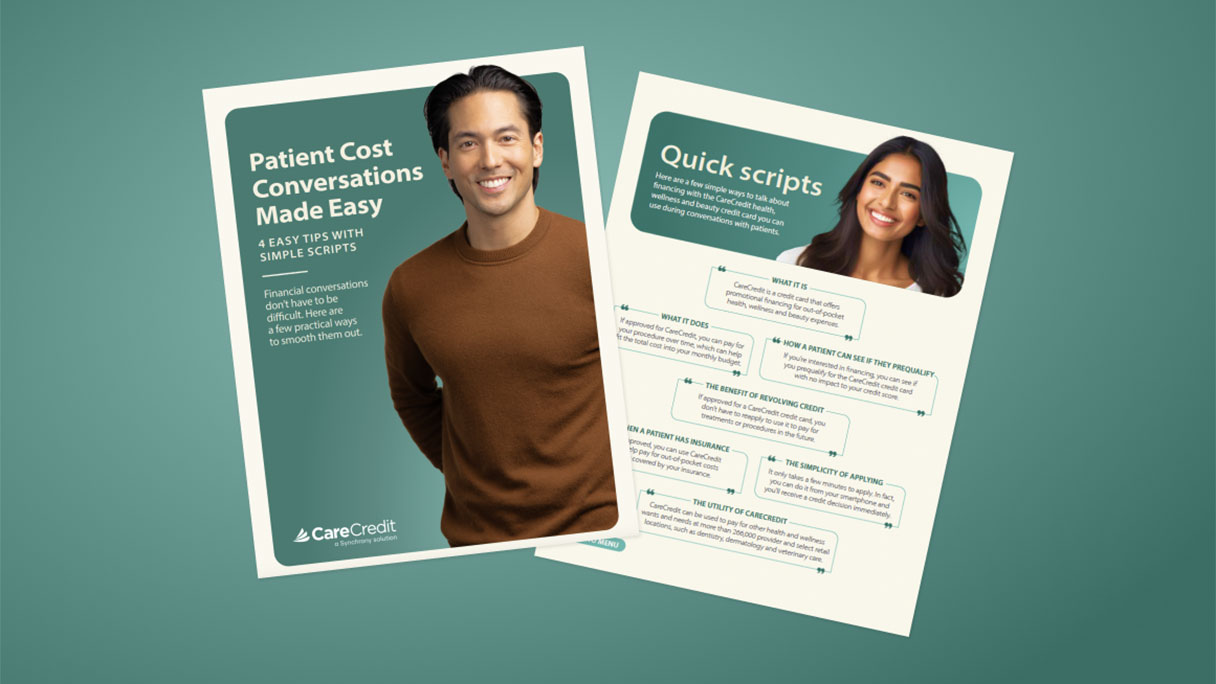How Ophthalmology Patient Financing Can Help Bridge the Gap to Care
Out-of-pocket costs are a growing concern faced by those who seek vision care. By offering financing options, providers can help ease their patients' cost concerns while also helping their practice grow.
By Suchi Rudra
Digital Writer
Posted Jun 20, 2025 - 6 min read

Out-of-pocket expenses, whether expected or not, can present a challenge for many patients who require eye care services. With rising costs of supplies and products, many eye care providers have raised the prices of their products and services. This can create a growing barrier for patients to move forward with eye treatments or surgeries, and can slow things down for your practice — but that's where financing options may be able to help.
Ophthalmology Care and Costs Today
The ophthalmology industry is experiencing various changes that are affecting the finances of both providers and patients. To keep their practices strong, eye care providers may need to adapt to changing patient demographics and rising care costs.
Baby boomers and the surging eye care demand
The large baby boomer demographic is getting older, and this has led to the United States population becoming older than it's ever been. In 2020, the number of Americans aged 65 and older stood at 54 million, a number that is projected to reach 80 million by 2040.1
Both eye care providers and patients will be affected by this trend, as demand for eye care — especially cataract surgeries — has never been stronger and will continue to grow over the coming years.2 A study found that there will be a 24% increase in demand for ophthalmologists by 2035, while the number of full-time ophthalmologists is predicted to decrease by 12% in the same time frame.3 With fewer eye care providers to choose from, the costs of eye care services may go up.
Rising costs and challenges in ophthalmology care
In 2024, the average cost* before insurance for cataract surgery with a single monofocal lens was between $3,400 and $7,395, depending on the state/district. For cataract surgery with a single toric lens, which often reduces the need for glasses, the average cost* was between $4,200 and $9,555. The cost can quickly increase if additional procedures are needed, such as correcting severe astigmatism, as well as any follow-up visits, medications or potential secondary treatments.4
One study found that more than half of patients surveyed (56%) struggle to cover their out-of-pocket eye care costs, which can be an average of $1,850 for eye surgery. And while 72% of ophthalmology providers surveyed do recognize that cost may be a barrier to scheduling appointments, only a small number offer flexible payment solutions to their patients.5
Despite available Medicare benefits, the quickly growing senior population is especially vulnerable to cost as a barrier to moving forward with healthcare services or treatment. Another recent study found that in the U.S., one-third of surveyed adults 65 and older who claimed to be in poor or fair health skipped care or recommendations, including medical tests.6
Patient Financing: A Path to Timely Eye Care
The good news is that flexible financing is a solution that can help patients pay for ophthalmology care costs not covered by private insurance or Medicare. A flexible financing option can offer the patient the freedom and flexibility to spread their costs over time. The CareCredit credit card, for example, is a patient financing solution that can help patients fit the cost of eye care into their monthly budget.
Financing solutions can empower the patient to say yes to care when they want or need it, rather than delaying care or ignoring doctor recommendations, which can lead to a worsening of their condition or even more expensive treatment. In fact, it's an occurrence that happens often: One study revealed that over 25% of surveyed Americans delayed a recommended procedure and 17% ignored the doctor's recommendations due to costs.7
Payment options like CareCredit offer promotional financing to make it even easier for patients — and their providers — to get the process started. With no hidden fees, no annual fee and no impact to their credit score to see if they prequalify, patients get peace of mind, while helping providers maintain their business goals.
Offering patients the support and confidence they need
Presenting financing options in your practice can be a simple and straightforward process — and it also can make a big difference for your patients. Offering flexible financing options to help patients to move forward with care could lead to significant changes in their lives.
Ophthalmology care can be an emotional journey, affecting the patient's self-esteem and confidence. For instance, cataract surgery can give the patient the ability to see the world clearly again. A patient who undergoes LASIK surgery might feel a renewed sense of confidence because they don't have to wear glasses anymore. But these services might only be feasible for patients if there's a flexible financing solution, since the average cost* for LASIK is $1,560 per eye.4 This cost is nearly double what most surveyed Americans in a CareCredit study estimate they spend on healthcare annually.7
What Ophthalmology Practices Are Saying
Concern over how to afford rising out-of-pocket expenses can lead to deteriorating eye health, making the ability to obtain timely vision care even more significant than ever. When an ophthalmology provider offers financing solutions, it can help patients to move forward with care recommendations, as Meg Munro, a director at OVO Lasik + Lens in St. Louis Park, Minn., points out.
“The CareCredit credit card benefits our patients by allowing them to go forward with procedures that improve their quality of life without having to wait until they have all of the financing right up front,” says Munro, who is a CareCredit cardholder herself.
Yasmin Lusson agrees and notes that at Fisher-Swale-Nicholson Eye Center in Bourbonnais, Ill., where she works as a clinical manager, staff members guide patients through the steps of the CareCredit credit card application, which is an easy process for both staff and patients.
“I think that offering financing opportunity and options for patients is very important. [It] is giving the patient freedom [from] financial burden while also helping us give [them] the best care,” says Lusson.
Providing Financing, Helping Patients
Costs are rising for everyone. While patients seeking vision care need help with out-of-pocket expenses, ophthalmology providers want to keep attracting and retaining patients. But, as some vision care practices have noted, there is a way to address both of these challenges at once by offering flexible payment options to patients.
Show patients you care by being aware of their budget concerns with a financing solution.
A Patient Financing Solution for Ophthalmologists
Cost may be a barrier to care for many of your current and prospective ophthalmology patients. You can help them manage the cost of the care they want or need by offering CareCredit as a financing solution. CareCredit allows patients to pay for their eye exams, LASIK, surgeries and other treatments over time while helping to enhance the payments process for your practice.
When you accept CareCredit, patients can see if they prequalify with no impact to their credit score, and those who apply, if approved, can take advantage of special financing on qualifying purchases.** Additionally, you will be paid directly within two business days.
Learn more about the CareCredit credit card as a patient financing solution for your ophthalmology practice, or start the provider enrollment process by filling out this form.
Author Bio
Suchi Rudra is a content writer and journalist with more than 15 years of experience in creating B2B content for small businesses and major brands and writing reported feature articles for consumer and trade publications. Her writing has focused on emerging tech and entrepreneurship, real estate, sustainable building plus design, travel and education.
Healthcare payment and financing solution
The CareCredit health and wellness credit card helps improve the payment experience for patients and clients, and your financial performance.
Get StartedReady to help more patients and clients get the care they want and need?
Get StartedReady to help more patients and clients get the care they want and need?
Get Started*Actual cost may vary based on geography, provider and other variables. Cost information is based on research in the 50 United States and the District of Columbia, which was conducted by ASQ360° in 2024 on behalf of Synchrony’s CareCredit.
**Subject to credit approval.
The information, opinions and recommendations expressed in the article are for informational purposes only. Information has been obtained from sources generally believed to be reliable. However, because of the possibility of human or mechanical error by our sources, or any other, Synchrony and any of its affiliates, including CareCredit, (collectively, “Synchrony”) does not provide any warranty as to the accuracy, adequacy, or completeness of any information for its intended purpose or any results obtained from the use of such information. The data presented in the article was current as of the time of writing. Please consult with your individual advisors with respect to any information presented.
© 2025 Synchrony Bank.
Sources:
1 “The U.S. population is aging,” Urban Institute. Accessed May 16, 2025. Retrieved from: https://www.urban.org/policy-centers/cross-center-initiatives/program-retirement-policy/projects/data-warehouse/what-future-holds/us-population-aging
2 Glover, Darryl. “Eye care workforce crisis: Why we urgently need more optometrists and ophthalmologists,” Defocus Media. May 19, 2025. Retrieved from: https://defocusmediagroup.com/optometrist-ophthalmologist-shortage/
3 Berkowitz, Sean T. et al. “Ophthalmology workforce projections in the United States, 2020 to 2035,” Ophthalmology. September 20, 2023. Retrieved from: https://www.aaojournal.org/article/S0161-6420(23)00677-2/fulltext
4 2024 Synchrony Average Procedural Cost Study for Cosmetic, Dental, Veterinary, Vision and Other Practices Across the United States, conducted by ASQ360° Market Research, Cost Tables.
5 Healthcare Journey Research Consumers and Providers report, Synchrony, 2023. (CareCredit is a Synchrony solution.)
6 Gunja, Munira Z. et al. “Health care affordability for older adults: How the U.S. compares to other countries,” The Commonwealth Fund. December 4, 2024. Retrieved from: https://www.commonwealthfund.org/publications/issue-briefs/2024/dec/health-care-affordability-older-adults-how-us-compares-other-countries
7 2022 Lifetime of Healthcare Costs, Synchrony. August 2022. (CareCredit is a Synchrony solution.)




